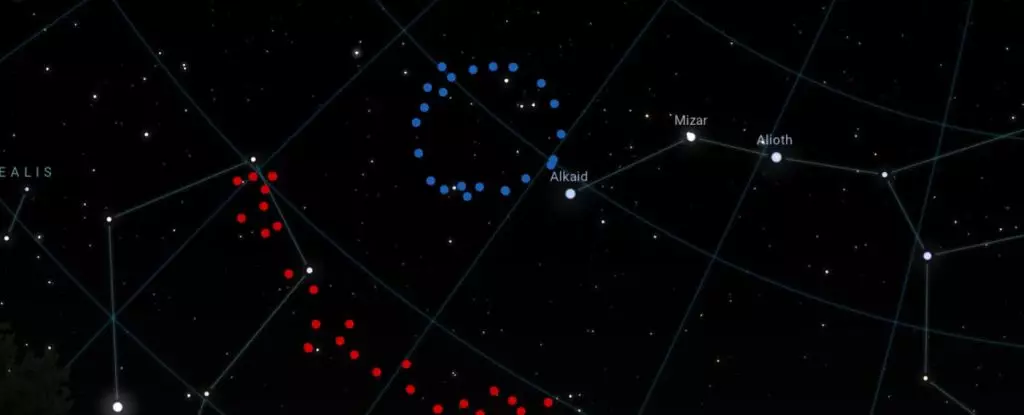In a groundbreaking discovery that defies conventional astrophysical understanding, astronomers have identified an immense galactic formation in the distant Universe: the Big Ring. This remarkable structure, observed through light that has traveled 6.9 billion years to reach Earth, comprises an almost flawless ring of galaxies stretching approximately 1.3 billion light-years in diameter. The significance of the Big Ring is not merely in its size but in the profound implications it has for our understanding of cosmic evolution. Alexia Lopez, leading this pioneering research from the University of Central Lancashire, presented her findings at the 243rd meeting of the American Astronomical Society in 2024—an event poised to shift paradigms in cosmology.
The Anomaly Against Cosmological Models
Historically, the prevailing cosmological model—the standard model—asserts a uniform distribution of matter across the Universe at large scales, as captured by the Cosmological Principle. This principle implies that any significant patch of space should mirror any other, leading to the expectation that structures larger than approximately 1.2 billion light-years should not exist in the observable Universe. Enter the Big Ring, which not only surpasses this limit but also reinforces the existence of the Giant Arc—a neighboring structure revealed in 2021 that adds a further layer of complexity to our cosmic narrative.
Lopez illuminates the quandary of this discovery effectively: “Neither of these two ultra-large structures is easy to explain in our current understanding of the universe,” a statement that encapsulates the confusion and challenge faced by astronomers in reconciling such anomalies with established theories.
Do Baryon Acoustic Oscillations Offer Clarity?
The connection between the Big Ring and other known galactic structures like Baryon Acoustic Oscillations (BAOs) is a tantalizing subject of investigation. BAOs are known as circular arrangements of galaxies that emerged from acoustic waves in the early Universe—essentially cosmic fingerprints of sound waves that became imprinted in the fabric of space as it expanded. However, unlike BAOs, which are defined and uniform in size, the Big Ring exhibits a corkscrew-like shape, suggesting a radically different formation process.
The fascinating possibility that this structure defies even our conceptualization of BAOs raises important questions. What does this mean for our quest to demystify the evolution of cosmic formations? It challenges the very nature of our theoretical frameworks and compels us to think critically about what we know.
Cosmology’s Evolving Landscape
In light of the Big Ring’s discovery, it is essential to reconsider and perhaps reconfigure our theoretical models of cosmology. The standard model, while adept at explaining many phenomena, falls short when confronted with the enormity of the Big Ring and its implications. Alternative theories, such as Roger Penrose’s conformal cyclic cosmology, suggest that the Universe may undergo continuous cycles of expansion. Such models could potentially accommodate structures like the Big Ring, albeit they come with their own set of challenges.
Another intriguing perspective points to the possibility of cosmic strings—topological defects in the fabric of space-time that could account for these extraordinary structures if they exist. Like wrinkles frozen in time from the intense conditions of the early Universe, these hypothetical cosmic strings introduce a more intricate layer to our understanding, despite the scarcity of empirical evidence to support their existence.
The Path Forward: Searching for Cosmic Arrangements
As astronomers grapple with the implications of these findings, the pursuit of more structures akin to the Big Ring becomes vital. Lopez poses a provocative thought: could these massive formations be mere chance arrangements of galaxies, an improbable cosmic coincidence? This unsettling idea suggests that as we peel back the layers of our understanding, we may very well rediscover the nature of the Universe in unforeseen ways.
To navigate this enigmatic terrain of cosmic discovery, scientists are urged to expand observational efforts. The hope is that through telescopes peering deeply into the cosmos, researchers might unveil additional formations scattered throughout the Universe, offering clarity and perhaps even redefining our perceived reality.
Rethinking Our Place in the Cosmos
As we stand on the threshold of what could be a revolutionary shift in the understanding of our Universe, the discoveries made by Lopez and her team charm us with the deep-seated promise of inquiry. The mysteries of the Big Ring and the Giant Arc are not simply cosmic puzzles; they are windows into the unknown, beckoning us to reevaluate the very underpinnings of cosmic evolution and the laws governing our reality. In the face of the profound unknown, one thing remains certain: the Universe is far more complex—and beautiful—than we have ever imagined.

